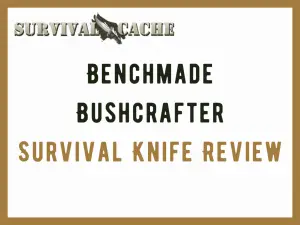
Up until recently, the quiet corner of outdoor activity known as bushcraft was a niche market for those who make knives and other wilderness survival equipment targeting extreme survivalists. But when Benchmade and Spyderco launched their own bushcraft knife contributions into the very small circle of blade makers who target a specific product to those who practice firestarting, snare-making, shelter building, and woodworking whose aficionados are known as bushcrafters, there’s no hiding now; Bushcraft has gone mainstream!
SKIP AHEAD
Benchmade Bushcrafter Review: Bushcraft 2.0
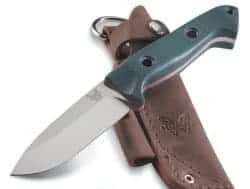
Basically, the Benchmade Bushcrafter is a 21st century version of a bushcraft knife. In fact, it might not be too much of a stretch to consider the Benchmade Bushcrafter a “Tactical Bushcraft” knife. From point to butt, the Benchmade Bushcrafter is a modern update to an age old question: What are the best qualities of a bushcraft knife? So as the bush evolves, thus evolve the tools to engage it. The list of blade deviations from the traditional include: steel type, steel hardness, edge grind, blade length, and blade shape. The breaks from classic design on the handle side include: overall handle shape, handle contours, handle materials, even the color, and a couple more characteristics to be mentioned later.
| KNIFE | DETAILS | ||
|---|---|---|---|

Recommended
|
|
Check Price on Amazon.com
|
One way to address the threats to classical bushcraft knife design is through dry statistics. Begin by taking an honest look at what you (or almost anyone else but Ray Mears) will do with a bushcraft knife. Follow these three steps:
- Make a list of the potential uses. Go ahead, be imaginative since the glorious statistical standard deviation will wash out all the fantasy.
- Now take a hard look at your list and rank it according to those things that you are most likely to use the knife for compared those tasks for which you are rarely or possibly never going to use the knife.
- Now divide up the possible uses with the percentage of use you think the knife will actually be used for. Lots of folks buy off-road vehicles yet put them in 4WD only a few days a year if that. Do you want to carry a knife for those rare needs, or one for high performance daily work?
With little effort, the Benchmade Bushcrafter eats realistic outdoor tasks for breakfast with room left over for extreme use. It is a substantial slab of premium S30V supersteel forged into a nine-inch knife. The cutting surface is about four and three-eighths inches as the crow flies and the handle scales take up another four and three-quarters inches. In other words, the blade is big enough and the grip fills your hand with room to spare. And it’s not just me who believes this.
Disclaimer
I’ll be honest here. From the moment I first saw a picture of this knife, I knew I would be happy with it. There was just something about the blade shape and grip that triggered love at first sight. I’ve used more than my share of knives, especially those with bushcraft leanings, so my preferences for knives as well as handguns, dogs and off road vehicles is pretty much dialed in. Not that my choice is always the right choice, but more it’s an honest admission that there are particular attributes I find attractive, and others I don’t. I suspect you are much the same.
Bushmeat
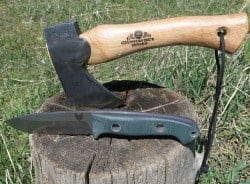
Compared to many other knives the weight of the Bushcrafterer knife is exaggerated by its solidity. The blade is thick as it should be being a real bushcraft tool and all, as well as an impressive and expensive slab of S30V steel. The thickness is a tall 4.1mm or 0.16 inch. And I am a big fan of the handle design. The shape of the scales is reminiscent of the canoe-handled folders of the past, but swells in all the right places. Both the front and rear of the scales round up into handle features that will stop a sliding hand. While some bushcrafters might feel constricted by Benchmade’s grip parameter reinforcements, others will relish in the added force that can be applied without fear of sliding one’s skin across the narrowest portion of the blade.
Also Read: 7 Thing You Need To Know About Bushcraft
Since it’s release in 2013, some other reviewers complained about the grip; with the length too big or too small, the grip too thick or thin. Or that the suggested finger placements were unnecessary on a true bushcraft grip. And of course it wouldn’t be internet reviewing if the knife critics didn’t also express discomfort about the handle color with them wishing for something else regardless of what “else” actually is. Good grief, this isn’t a black ops tactical knife. It’s a woods and outdoor skills-friendly blade. Well, I take that back. Keep reading.
Beauty of the Beast
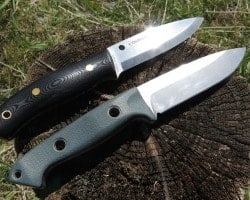
The contoured light forest green color of the scales is a nice touch, and given that they are made of proven G10 material only makes it better. Red vulcanized spacers occupy the land between the G10 and the S30V, all held cozy by pressed-in titanium tubes. The three Ti tubes offer plenty of tie-in access should the Bushcrafter need to be demoted to mere sharp point of a spear.
The grip fits perfectly in my large hand, and all reasonable use positions feel secure and precise. In contrast, the Spyderco Bushcraft knife has fewer limits placed on hand location, and represents a near-traditional take on the classic bushcraft knife. However, after even a brief use of the Benchmade Bushcrafter it is obvious that the more defined ends of the grip are assets to be exploited rather than limits to be shunned.
Also Read: Spyderco Bushcraft Knife Review
Benchmade also deviated from tradition with it’s steel. Many in the bushcraft world are happiest with a high carbon tool steel such as D2 or the O1 steel that Spyderco chose. By choosing a stainless supersteel for a bushcraft blade Benchmade made a noteworthy tangent in need of further exploration. The modified drop point design is not by chance. The shape and profile have evolved through centuries of cutting instruments resulting in a perfect mix of point and edge.
Benchmade’s choice of S30V is a notch above other so-called supersteels like 154CM which is considered Benchmade’s house steel. Tool steels have a tendency to require a little more attention to remain rust and stain free for those who care about such things. The performance of tool steel is excellent, but only if you measure with a yardstick for those qualities where tool steel shines. Benchmade made the conscious decision, well actually Shane Sibert, who designed the Bushcrafter made the call, to explore new steel galaxies and boldly go where no bushcraft knife has gone before. And as expected from Sibert, the Bushcrafter is built for heavy use with none of the minimalism or shortcuts.
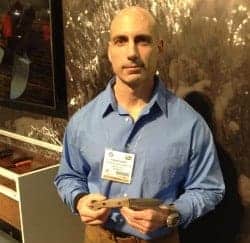
Shane Sibert’s Benchmade Bushcrafter had it start with one of his original designs named the Cascadia Bushcrafter knife. The Cascadia, in addition to selling for at least $425 (and selling out!), has more textured Micarta grips, aggressive traction grooves on the early spine, a 2” long fuller (blood groove), and the bolder highlights we’ve come to love about Sibert’s overbuilt knives.
Benchmade Bushcrafter 162 Details
- Blade Type: Polished high ground drop-point
- Blade Length: 4.43″
- Blade Thickness: 0.164″ (4.2mm)
- Blade Hardness: 58-60 HRC
- Handle Thickness: 0.92″
- Weight: 7.72 oz
- Overall Length: 9.2″
- Sheath: Brushed full-grain buckskin
| KNIFE | DETAILS | ||
|---|---|---|---|

Recommended
|
|
Check Price on Amazon.com
|
The S30V stainless steel is a great choice for this kind of knife. Some prefer tool steel, some high carbon, but me it’s S30V, even over the other popular flavors. There are several ways to approach the topic of steel type for a true bushcraft knife. One is just raw durability, another is edge holding, a third is ease of sharpening, a fourth is maximum sustained sharpness, and a fifth is required care. In my experience with other steels, I appreciate the features of S30V including its hardness, resistance to the elements, and lack of required care. It might be harder to put an edge back on, but it will take longer to degrade the edge in the first place.
Ahh, The Sheath.
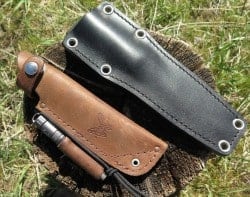
For bushcraft duties, I really appreciate this sheath. Not only is the buckskin leather a nice touch, but it is minimalist in size. Kydex is fine for sheaths, but so many of them are much wider than the knife, some so much so they could double as a canoe paddle. Yes, this sheath does ride a little higher than some, but it actually presents the knife better than low hanging ones. For frequent drawing and resheathing, you will appreciate the position over what are essentially two-handed designs. Further, the sheath works exceptionally well when you are sitting which is a common position in real bushcraft. The sheath keeps the knife well positioned for use without pushing up on your belt. The leather and stitching are first rate. There is a nylon/plastic liner within the sheath cradling the blade and, the fit is snug enough to hold the knife well when not snapped.
Also Read: Benchmade Adamas Knife Review
The D-ring is a welcome attachment point for wearing options; another belt option using a not-included dangler, hanging it in camp, and quick attachment to packs, pants, bags, etc. D-rings today might be seen as a throwback to the last century and even the one before that. But real bushcraft has not changed in that time, so neither should the features on a dialed-in sheath.
Also in the spirit of the traditional bushcraft knife this sheath has an accessory pocket tube, or flint loop in bushcraft parlance, for a fire steel. I am using the Exotac fireROD Tinder Capsule. It fits perfectly, contains a small watertight compartment for fire tinder, and barely hangs lower than the leather designed to hold it. For added security I’ve included a bungee lanyard to the firesteel. The robust spine of the Bushcrafter is perfect to slice down the firerod so you don’t have to use the business side of the blade. But I doubt the S30V steel would even notice. In fact, the earliest versions of Bushcrafter’s were a little soft in the harsh spine corner department so Benchmade beefed up the angle to accommodate the fire striking duties of this knife.
A Funny Thing Happened on the Way to the Dive Knife…
While Benchmade was working in their fourth attempt at a water knife (their third fixed blade version), they headed down the coast to San Diego to talk with the Navy SEAL/BUD (Basic Underwater Demolition) folks to get their opinions on the best features of a water knife. But in the meantime, they noticed an unusually high number of Benchmade Bushcrafter being carried by the special ops boys. WTF? Why would a bushcraft knife known for its woodworking blade and multi-grip handle be front and center at a SEAL training facility. Well, it turns out that the Benchmade Bushcrafter, in addition to an excellent bushworthy/survival blade, is also an excellent EOD knife. That’s EOD as in Explosive Ordnance Disposal. EOD often requires the precise cutting of C4 plastic explosive and the Benchmade Bushcrafter’s thick and powerful S30V steel blade handles the task better than most.
Also Read: Fallkniven F1 Survival Knife Review
Not to miss an opportunity, the knife engineers at Benchmade asked the Special Ops guys how they could make the Bushcrafter even better for EOD use. The reply was simple: 1) Desert sand colored scales and 2) a Kydex sheath. There is now an EOD Bushcrafter with those two more deviations from original green scales and leather sheath. So I guess this is really a bushcraft blade for the world we actually live in.
Hang On
The Benchmade Bushcrafter is at home in the 21st century and the 17th century and all centuries in between. Regardless of all the high tech improvements note above, the real test of a good bushcraft knife is how it performs in the hand. To test out the Benchmade Bushcrafter, eight of the most common grips were explored in both feel and woodworking prowess. The grasps go by many names, but in an nutshell, here are eight of them You might also want to check out this YouTube video for visuals.
Forehand grip: This is the most common grip where the blade away is pushed or sliced away from the user. Almost every knife works great in this grip since it is the most natural. The lightly canoe-shaped scales provide a firm hold. No issues here.
Backhand: This position mimics the forehand grip but aims the cutting edge towards the user. The backhand hold on the knife is as positive or better than the forehand grip since, in at least my hand anyway, the major axis of my palm is held firmly by the canoe-tip guards.
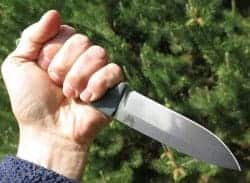
Scissor Grip: This grip holds the knife close to chest and cutting leverage is created by small rotational right and left hand movements like scissors where one hand holds the blade and the other holds the workpiece. The blade and workpiece are scissored with chicken-wing movements of the elbows. In this case the Bushcrafter works very well due to the ability to choke up on the blade placing the thumb on the thick steel spine. I’ll admit that the defined bolster area at the index finger (canoe bow) limits the exact positioning of the blade compared to less defined bolster grips like the Spyderco Bushcraft does, but once balanced, the scissor grip will work fine for as long as you need it.
Thumb push: By holding in a forehand grip, the thumb is used as a fulcrum to lever the blade in short, powerful, controlled movements. The massive (relatively speaking) spine of the Bushcrafter makes thumb pushing the blade 100% natural.
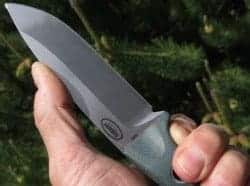
Pull-stroke grasp: The blade is drawn towards the chest of the user where the workpiece is held in place against the body and the tight elbows are used as the safety stop. This is one grip where the length of the blade is noticeable. The Bushcrafter is on the bigger end of traditional bushcraft knives and this is one place where size matters, er, well, gets in the way… a little.
Finger Push Grasp: The fingers roll up on the spine of the blade and cut or carve through knuckle and joint flexing of the fingers. The limited movement of the fingers prevent the blade going anywhere unsafe. Very much like the Thumb push grip, the finger push also benefits from the thick spine and heavy balance of the Bushcrafter.
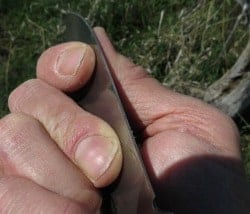
Thumb Grasp: This pinch grip pushes the blade towards the thumb using the hand along with the thumb to confine the workspace to the inch or so of gap between the two. Usually the spine of the blade is hooked into the index finger’s second joint. It’s the cut often used in the kitchen for paring and chopping without a cutting board. The Bushcrafter’s blade is on the deep side for the Thumb Grasp but then again, wood is not carrot.
Fulcrum Grasp: By using your non-knife holding hand’s thumb to pressure or rock the blade while also holding the workpiece, you can get precise slicing and leverage for small cutting jobs. The Bushcrafter’s weight is noticeable here, along with the girth of the blade which lessens the diameter of the wood gripped in your hand.
Verdict
If your survival fantasy has you stuffing steel into zombie grey matter, then perhaps I could suggest a few other blades more to your liking. But if you intend on making the best with what nature hands you, then the Benchmade Bushcrafter knife should be at the top of your grocery list of survival choices. Either way, if the Benchmade Bushcrafter is good enough for the serious outdoorsman and the Navy SEALs, then you might have a hard time defending why it’s not good enough for you.
| KNIFE | DETAILS | ||
|---|---|---|---|

Recommended
|
|
Check Price on Amazon.com
|
Note: My colleague, Michael Major (ex-military), also ranked this knife as one of the top bushcraft knives on the market in this article here.
Photos By: Doc Montana, Benchmade, Survival Cache Team

